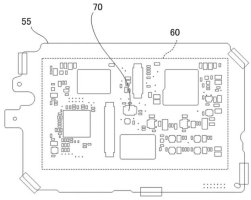This is a improvement to two IBIS patents issued several years ago with the main feature of miniaturizing the gyros. Its otherwise the same patent from 2006 and 2008 which will be soon expiring. Its common for patent owners to make changes or add features in order to expand patent life or take advantage of new technology to make them more practical to manufacture.
It is a In Body Camera Stabilization, sometimes referred to as IBIS, the gyros are mounted on the rear of the sensor.
Some Relevant portions where I've highlighted what I think are keys.:
[Patent document 1] JP 2008 - 089995A
[Patent document 2] JP 2006 - 317848A
[Summary of Invention]
[Problem to be solved by the invention]
[0006]
However, in using a plurality of shake sensors as disclosed in a Patent document 1, the big space which arranges these is needed and it bars the miniaturization of a camera. When arranging a shake sensor in a camera as disclosed in a Patent document 1 and 2 and a shake sensor and the component which fixes it are subject to the influence of vibration of the internal unit of a camera, it becomes impossible to detect camera deflection normally. For example, when a shake sensor detects camera deflection, detection of normal camera deflection becomes impossible by being subject to the influence of vibration which the motor which drives the shutter unit which is an internal unit generates. Also when driving the variable power lens and focus lens in a taking lens to optical axis direction, detection of normal camera deflection becomes impossible by vibration which occurs from these power supplies for a drive.
[0007]
The present invention provides the small imaging device which enabled it to detect camera deflection with high precision with a shake sensor.
[Means for solving problem]
[0008]
An imaging device as a one side face of the present invention is provided with the following.
An image sensor which images an object image.
An image sensor substrate which has a front face and a back face of an opposite side on the object side and in which an image sensor was mounted in front.
A shake sensor which detects deflection of an imaging device.
It is mounted in the back face of a shake sensor and an image sensor substrate.
[Effect of the Invention]
[0009]
According to the present invention, the small imaging device which can detect camera deflection with high precision with a shake sensor is realizable.
Here is the diagram:
"Fig.1 shows. The image sensor substrate 55 is arranged so that it may have the front face and back face (back surface) which intersect perpendicularly with the optic axis from an imaging lens unit to the image sensor 60."
"The angular velocity sensor 70 is electrically connected to the back face of the image sensor substrate 55 while being held by soldering."

